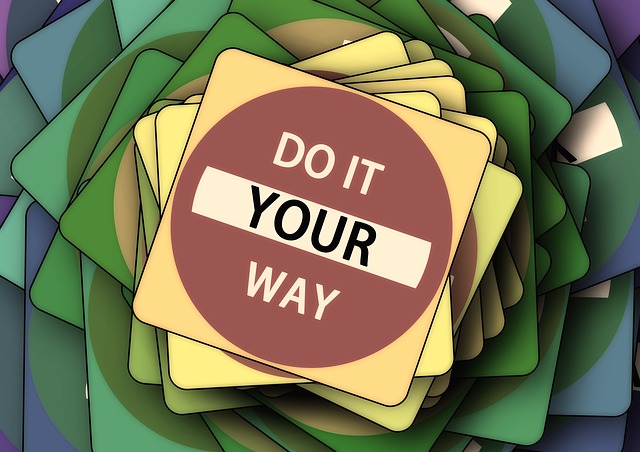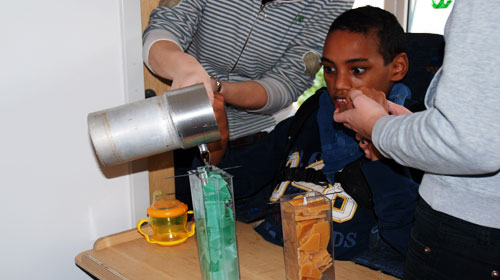Transition to adulthood
3. Supporting my child
3.3. Concerning Independence

Photo: Pixabay.com
In this chapter you will find suggestions on how you can support your child in the process of becoming independent. The following areas will be discussed in more detail:
Promoting strength (3.3.1.)
Finding new learning fields (3.3.2.)
Using the trust of external people in the child (3.3.3)
ACTIVITY: “Create activity cards”
a.) Consider a household activity that your child learns or takes over.
b.) Create an "Activity Card" with your child.
An example for an activity-card: Cleaning a bathroom

3.3.1. Promoting strength
Young people need a strong self-esteem.
"Good looks, sports activities and friends usually contribute to a good self-esteem. Young PWID must know their strengths and at the same time cope with their weaknesses, for example with an appearance that may not correspond to the conventional ideal of beauty." "Ultimately, they have to be able to do more than other to be accepted to be different and still liked." [18]
Photo: IB Sued-West gGmbH
To develop strengths, children with severe disabilities need support. It is important to respond to the individual situation of the child and to find a balance between support and demands. Special support approaches have been developed for special forms of disability, e.g. the TEACCH concept for children with autistic disorders.
The trend in psychology and education – focusing on strengths rather than shortcomings - comes in various forms and approaches, such as salutogenesis and resilience concept, and has led to a resource-oriented attitude.
Resources are factors that can strengthen people in a situation.
"They can be created both in the persons themselves (personal resources) and also be brought to the person by the environment (environmental resources). If resources are pronounced, they support human development also by compensating for deficits and developmental disorders". [19]
Everyone has strengths.
For some they are intensive, for others less so. In some cases, the soft factors are "slumbering" and are still undiscovered. When people are asked about their strengths, they often do not have a clear and convincing answer and they have to first think long and hard.
So how do you intend to use your strengths, if you are not aware of them? By going on a search (be a treasure hunter!):
Make it your task to identify and use the strengths and abilities of the children. Helpful questions are: What is your child really good at? What is very easy for them? Do they have any special skills?
Include your family, friends and acquaintances because their opinion is from the "outside" and of great importance that opens new perspectives!
It is crucial that you become aware of your strengths from time to time, develop them and, above all, actively use them. As with any training, the practice makes you a "master".
Be creative and visualize strengths, e.g. through a collage, or collect the strengths and resources in a treasure chest that can be retrieved when necessary.
Compare your child less with other children in their development but rather look at their uniqueness. The best way to keep track of developments is to regularly draw up small advancement plans and reports.
Every human being has resources that are more or less activated and are available for coping with life situations. [20]
Encourage talent because our expectations for success are influenced by how much we believe in our strengths. [21]
Look for role models and exemplary people for managing disability in adulthood. - Role models, idols, quotes can steer your actions in the desired direction. Imitation is one of the three major ways of learning. "Models show you that what you still consider impossible in your mind has long been a reality in somebody’s life."
For the adolescent it can create a very frustrating situation, if they lack chances to practice independence. [22]
How you can support your child with it:
Be aware that encouraging your child to become more autonomous does not mean abandoning or desert the child. [23]
How can young people (on a small scale) gain experience of being able to stand on their own two feet - even with the support of other people - but in such a way that they themselves are "in the centre"? Create incentives for it! [24]
3.3.2 Finding new learning fields

"In fact, the parents of PWID are suddenly confronted with desires, for example the acquisition of a driving license, which are not necessarily realizable. I emphasize "not necessarily", because there is no rule about it: I have often been impressed by young PWID by their abilities. Even if the chances of success are low, it is not good to spare your child a disappointment at all costs by preventing it from trying out. I refer to the example driver's license: I know parents who let their child take an hour of driving. It ended in failure, but at least they gave their child the chance to try. "[25]
Learning takes place unconsciously in many everyday life situations. Experiential knowledge, experimenting, trying out, absorbing and applying information - behind all these activities there is a learning process. Learning means sharing, creating, discussing and linking information. Learning means to become active. It requires curiosity and motivation from the individual.
The aim of all learning is to improve the quality of life by increasing the ability to act in a social, professional and private context. Learning is a lifelong, living process, that leads to a reflected relationship with oneself, with others and the world. [26]
How you can support your child with it:
Do not offer automatically "all-round care" any longer. Your children need resistance. They can't automatically get everything. To learn how to take responsibility, it is important, that your children learn something for themselves. [27]
Do you have any ideas on how you can incorporate gaps in their daily routine? Examples: Have them prepare their own lunch, fold together their own clothes, get up without wake-up service. Even if the carrot is not perfectly cut, practice makes you perfect.
More independence or a sense of achievement can be incentives for the completion of tasks. Children who have had to solve a number of problems themselves have proven to be happier. [28]
In order to create a sense of achievement, it is important to set challenges and assign tasks that are initially easy to complete and can be divided into very small steps.
These tasks make it clear what your child can and cannot do, what their development possibilities and limits are - including those related to disability.
Photo: IB Sued-West gGmbH
"Take advantage of educational opportunities!"
Educational opportunities help you to adapt to the demands of life.
With regards to people with disabilities, adult education has the task of facilitating new experiences and processing existing ones, [29] imparting knowledge and providing support for self-determination and shaping their life. [30] Information is important for making decisions.
PWID in particular often have problems making decisions as they had rarely been given options in the past. A largely self-determined life, however, means that decisions with more or less far-reaching consequences have to be made from time to time, e.g. the decisions for a job. [31]
How you can support your child with it:
Parents should encourage young people to discover and pursue their own interests or to actively respond to changes in everyday life.
Enable participation in educational opportunities.
3.3.3. Use the trust of external persons in the child
External support in adolescence has many aspects:
It helps young people to make experiences independent from their parents, e.g. in a peer group (chapter 2.3.5.), but it also helps you as parents to "let go" and develop a new relationship with your child.
Your child's self-confidence is strengthened through overcoming obstacles, courage and confidence. The more often your child is given the opportunity to try out (experiential spaces) and master things, the better they learn to deal with frustration and self-confidence will increase.
Parents repeatedly experience that things practiced for a long time will only start working with an external person. [32]
The confidence of external persons has the advantage that routines are interrupted. Even small changes in the process can require a rethinking and new behaviour. A "different" examination of the person and his strengths and weaknesses takes place, detached from the character of attachment and dependence.
How can you support your child here:
Are there tasks and roles that can be transferred to other family members and persons?
It is important that these other supporters help experimentation. This creates new development spaces.
Have you ever wandered which areas of your support tasks can be outsourced to external supporters or offers?